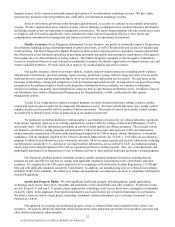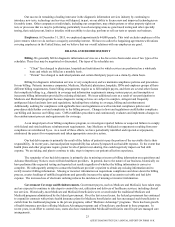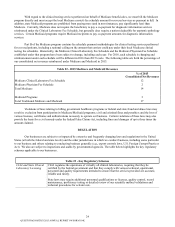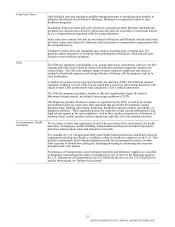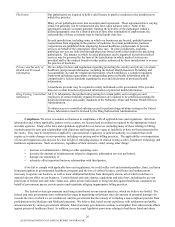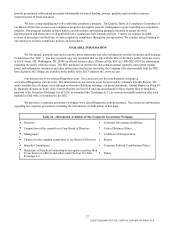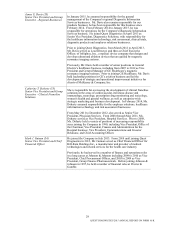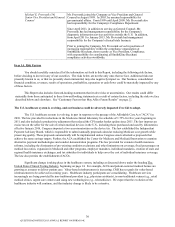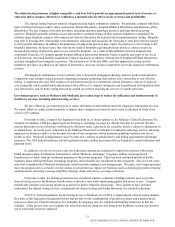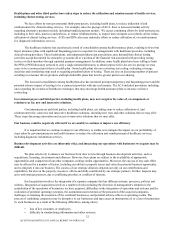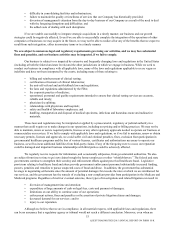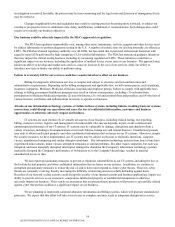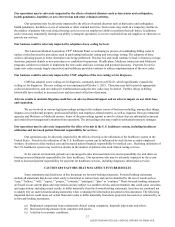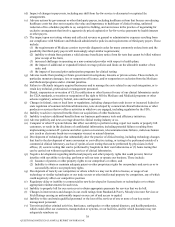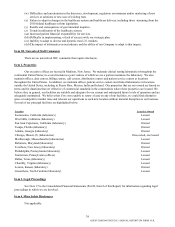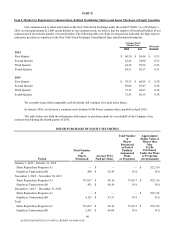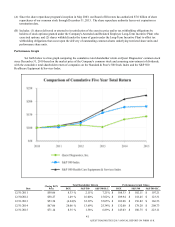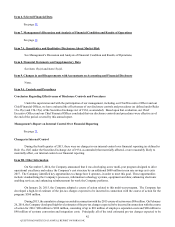Quest Diagnostics 2015 Annual Report Download - page 36
Download and view the complete annual report
Please find page 36 of the 2015 Quest Diagnostics annual report below. You can navigate through the pages in the report by either clicking on the pages listed below, or by using the keyword search tool below to find specific information within the annual report.32
Health plans and other third parties have taken steps to reduce the utilization and reimbursement of health services,
including clinical testing services.
We face efforts by non-governmental third-party payers, including health plans, to reduce utilization of and
reimbursement for clinical testing services. For example, since the passage of ACA, there is increased market activity
regarding alternative payment models, including bundled payment models. We expect continuing efforts by third-party payers,
including in their rules, practices and policies, to reduce reimbursements, to impose more stringent cost controls and to reduce
utilization of clinical testing services. ACOs and IDNs also may undertake efforts to reduce utilization of, or reimbursement
for, diagnostic information services.
The healthcare industry has experienced a trend of consolidation among health insurance plans, resulting in fewer but
larger insurance plans with significant bargaining power to negotiate fee arrangements with healthcare providers, including
clinical testing providers. These health plans, and independent physician associations, may demand that clinical testing
providers accept discounted fee structures or assume all or a portion of the financial risk associated with providing testing
services to their members through capitated payment arrangements. In addition, some health plans have been willing to limit
the PPO or POS laboratory network to only a single national laboratory to obtain improved fee-for-service pricing; we may
cease to be a contracted provider to a health plan. Some health plans also are reviewing test coding, evaluating coverage
decisions and considering steps such as requiring preauthorization of testing. There are also an increasing number of patients
enrolling in consumer driven products and high deductible plans that involve greater patient cost-sharing.
The increased consolidation among health plans also has increased pricing transparency and bargaining power and the
potential adverse impact of ceasing to be a contracted provider with any such insurer. The ACA included provisions, including
ones regarding the creation of healthcare exchanges, that may encourage health insurance plans to increase exclusive
contracting.
Government payers and third parties, including health plans, may not recognize the value of, or compensate or
reimburse us for, new and innovative solutions.
Government payers and third parties, including health plans, are taking steps to reduce utilization of, and
reimbursement for, some new and innovative healthcare solutions, including new tests and other solutions that we may offer.
These steps discourage innovation and access to innovative solutions that we may offer.
Our business could be negatively affected if we are unable to continue to improve our efficiency.
It is important that we continue to improve our efficiency to enable us to mitigate the impact on our profitability of
steps taken by government payers and health insurers to reduce the utilization and reimbursement of healthcare services,
including diagnostic information services.
Business development activities are inherently risky, and integrating our operations with businesses we acquire may be
difficult.
We plan selectively to enhance our business from time to time through business development activities, such as
acquisitions, licensing, investments and alliances. However, these plans are subject to the availability of appropriate
opportunities and competition from other companies seeking similar opportunities. Moreover, the success of any such effort
may be affected by a number of factors, including our ability to properly assess and value the potential business opportunity,
and to integrate it into our business. The success of our strategic alliances depends not only on our contributions and
capabilities, but also on the property, resources, efforts and skills contributed by our strategic partners. Further, disputes may
arise with strategic partners, due to conflicting priorities or conflicts of interests.
Each acquisition involves the integration of a separate company that has different systems, processes, policies and
cultures. Integration of acquisitions involves a number of risks including the diversion of management's attention to the
assimilation of the operations of businesses we have acquired, difficulties in the integration of operations and systems and the
realization of potential operating synergies, the assimilation and retention of the personnel of the acquired companies,
challenges in retaining the customers of the combined businesses, and potential adverse effects on operating results. The
process of combining companies may be disruptive to our businesses and may cause an interruption of, or a loss of momentum
in, such businesses as a result of the following difficulties, among others:
• loss of key customers or employees;
• difficulty in standardizing information and other systems;
QUEST DIAGNOSTICS 2015 ANNUAL REPORT ON FORM 10-K


